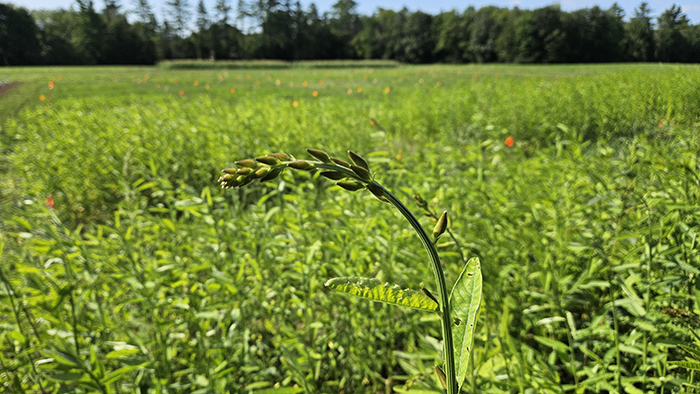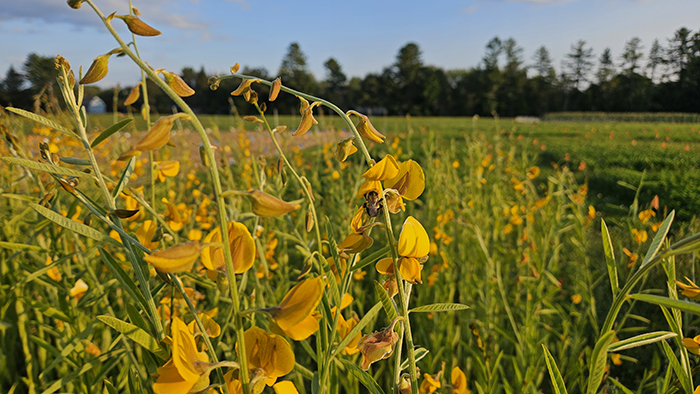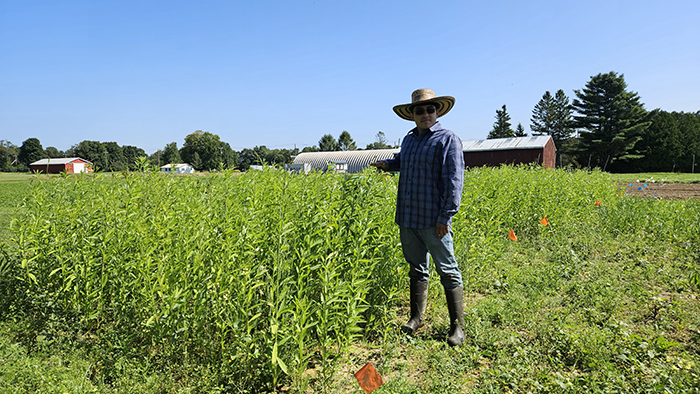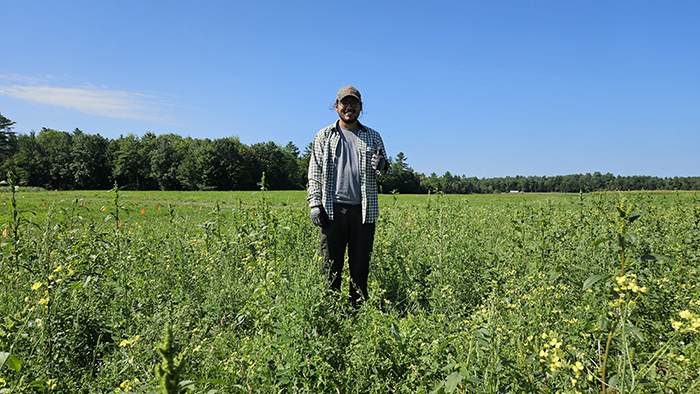Bulletin #9642, 2024 Maine Sunn Hemp Forage Legume Variety Trial
Bulletin #9642, 2024 Maine Sunn Hemp Forage Legume Variety Trial (PDF for printing)
By Jaime Garzon, Assistant Extension Professor and Forage Educator, University of Maine Cooperative Extension
For information about UMaine Extension programs and resources, visit extension.umaine.edu.
Find more of our publications and books at extension.umaine.edu/publications/.
Introduction
Sunn hemp (Crotalaria juncea L.) is a warm-season legume that is being researched and used in the southern United States as a cover crop or forage. It is commonly included in crop rotation with strawberries and tomatoes in Florida and is also a feed source for beef cattle in Florida and Alabama.
This plant has rapid growth and biomass accumulation, the potential to fix atmospheric nitrogen, and exert control of some potentially pathogenic microbial populations in the soil, such as nematodes (Meloidogyne incognita) or fungi species, such as Pythium spp., some of which may cause “cottony blight” and root damage. Additionally, sunn hemp’s rapid growth makes it suitable between cash crops during summer as a cover crop or an alternative feed source for ruminants in Maine.
Lastly, the Maine market currently does not offer any other plants with nitrogen-fixing potential that can be established in summer. Hence, the objective of this trial was to evaluate the performance and nutritive value of two varieties of sunn hemp marketed in the United States as a first approximation of this legume’s potential use in Maine.
Trial design, varieties, and measured variables
The study was conducted at the University of Maine, Rogers Farm, located in Old Town (ME) (44° 55’ 43” N; 68° 41’ 45” W) from June to September 2024. Two sunn hemp varieties (‘Loei’ and ‘Crescent Sunn’) were evaluated in a randomized complete block design with three replicates, which means each variety was planted in three separate plots.
Before planting, a soil test was conducted to determine nutrient levels in the experimental area. The test determined a Pushaw-Boothbay silt-loam soil type, with 6.0 pH, 4.0% organic matter, and 6.0 and 203 pounds per acre of phosphorus and potassium, respectively.
The area was disked several times until no vegetation remained on the soil surface. On June 2nd, 2024, sunn hemp was seeded in a prepared seedbed with a cone seeder at 16 pounds per acre seeding rate. The soil had already reached an average temperature of 65 °F, suitable for sowing warm-season forage species in Maine. The seeds were not inoculated because no specific inoculants were available for sunn hemp in Maine’s market.
After 60- and 90 days post-seeding, corresponding to pre-blooming and full blooming state, two areas of 20 by 20 inches were harvested with a sickle knife at ground level in each plot and used to calculate the yield on a dry matter basis. Two subsamples were also taken, dried at 176 °F for 72 h, and used for nutritive value determination. Crude protein (CP), neutral detergent fiber (NDF), total digestible nutrients (TDN), lignin, and NDF digestibility at 30 hours were determined by NIR analyses in DairyOne® lab.
Before the biomass sampling, preharvest canopy height was also evaluated with a measuring stick at five random locations per plot.


Figure 1. Sunn hemp in pre-blooming (a) and full blooming (b) state, corresponding to 60- and 90-days post-sowing in Maine.
Wheather conditions
Seasonal precipitation and temperature data were recorded at the trial location and are described in table 1.
Table 1. Average air temperature and precipitation in Maine’s summer in 2024 and the last decade.
| Month | 2024 | 2014-2023 | ||
| Temperature | Precipitation | Temperature | Precipitation | |
| (°F) | (inches) | (°F) | (inches) | |
| June | 64.6 | 5 | 61.2 | 3 |
| July | 70.5 | 3 | 68 | 4 |
| August | 66.7 | 4 | 66.7 | 3 |
| September | 59.4 | 1 | 59.4 | 4 |
The summer of 2024’s temperature was very similar to that recorded during the same months since 2014. However, there were differences in the precipitation pattern, with higher rainfall in June and lower rainfall in September compared to previous years.
Statistical analysis
All data were analyzed using mixed-model Analysis of Variance (ANOVA), in which blocks and their interactions were considered random effects. Treatments were considered different to a significance level ≤ 0.05
Results
Height and yield
Crescent Sunn and Loei yields were similar on the first harvest, 60 days after seeding. The varieties accumulated 4,251 and 3,413 pounds of dry matter per acre, respectively. While Crescent Sunn produced 838 more pounds on average than Loei, the variation in the plots within varieties impacted the statistical analysis, so it is probabilistically preferable to report a similar biomass production between both varieties.

Additionally, both varieties reached the same height of 53 inches at two months post-planting.
Crescent Sunn and Loei’s height and yield were greater during the second harvest, 90 days post-seeding. Both varieties reached 62 inches in height and produced approximately 5,000 pounds of dry matter per acre, accumulating 2,300 pounds more per acre than the first cut.
Figure 3 shows the weed control sunn hemp provided in the trial area during the summer. Both photos were taken the same day before the first harvest began. Figure 3a shows the homogeneous growth of sunn hemp, while Figure 3b displays the weed growth around the experimental area. Both areas were initially tilled and cleared when setting up the trial.


Figure 3. Weed control exerted by sunn hemp, comparing the incidence of sunn hemp (a) and weeds (b) with the height of UMaine research assistant, Mr. Marco Chusho.
Nutritive value
Both varieties had similar nutritive values in each cut. However, better quality was observed at the 60-day post-seeding harvest, except for the concentration of crude protein, which remained stable throughout the experimental period (Table 2).
Table 2. Nutritive value of Crescent Sunn and Loei varieties at 60- and 90-days post-planting.
| Nutritive variable | 60 days | 90 days | ||
| Crescent Sunn | Loei | Crescent Sunn | Loei | |
| (%) | ||||
| CP | 11.4 | 12.5 | 10.4 | 9.5 |
| NDF | 44.5 | 44.1 | 56.6 | 57.7 |
| TDN | 60.3 | 61.0 | 51.0 | 52.0 |
| Lignin | 6.2 | 5.8 | 12.0 | 12.3 |
| Digestibility | 45.8 | 49.4 | 29.3 | 23.8 |
The desirable values for nutritive value in Maine’s forages depend on the animal species and type, since lactating or pregnant females have a greater energy requirement than growing or dry animals or males. Additionally, horse diets should have a lower proportion of energy, to avoid laminitis or metabolic syndrome.
Therefore, a good quality forage is expected to have 15-25% crude protein, 40-60% NDF, 60-70% TDN, 5-6% lignin, and 50- 60% digestibility. Again, these values are not definitive and depend on the type of operation, animal, diet, and management.
The second harvest indicated sunn hemp in Maine continued growing and producing biomass after the pre-flowering period. The clipping 90 days post-planting showed the potential of both varieties to accumulate twice the biomass obtained at 60 days. However, the increase in yield was also paired with a decrease in nutritive value, represented by the increase of insoluble fibers (NDF and lignin) and a reduction in TDN and digestibility (Figure 4).

CP: Crude protein; TDN: Total Digestible Nutrients; NDF: Neutral Digestible Fibers.
Discussion
Sunn hemp accumulated over 4,000 pounds of dry matter per acre in 60 days post-planting. Other cold-season legumes, such as clovers or alfalfa, may reach greater yields, typically producing 6,000 to 10,000 pounds of dry matter per acre, but usually after a year of establishment. Buckwheat, another broad-leaf plant used as a cover crop for its rapid growth and nonchemical weed suppression, accumulates up to 1,500 pounds of green matter per acre, equivalent to 300-500 pounds of dry matter per acre.
The high yield of sunn hemp in a short time and without fertilization shows photosynthesis efficiency and effective soil nutrient utilization. However, this plant is best established in well-drained soils since high moisture impacts the root’s development and growth, causing less competition against warm-season weeds. Soils suitable for the growth of orchardgrass, smooth bromegrass, corn, sorghum, or alfalfa could be suitable for sunn hemp, but without the high fertilizer requirements of some of those crops.
Crude protein concentration averaged 11% throughout the entire experimental period (Table 2), which is a low value compared to other legumes, such as white clover (26%), red clover (24%), alfalfa (25%), or birdsfoot trefoil (26%). However, those cool-season legumes do not fit in calendars that require a short-term warm-season crop. Additionally, the yield and crude protein concentration reached in this trial showed that Crescent Sunn or Loei provided approximately 50 to 80 pounds of N per acre after being incorporated into the soil.
Moreover, longer growth time will encourage the accumulation of low soluble fibers (NDF) and lignin in sunn hemp tissues, decreasing TDN concentrations, digestibility, and potential as a forage resource (Figure 4). Previous research in other states shows that sunn hemp may control potentially pathogenic microbial soil populations for other crops due to alkaloids’ synthesis, accumulation, and exudation. These antinutritional molecules may negatively impact animal health after sunn hemp intake, especially monogastric animals such as horses, pigs, or poultry. However, the accumulation of alkaloids is concentrated in flowers, pods, and seeds. Thus, avoiding the consumption of these plant parts will avoid potential intoxication, reinforcing the sunn hemp forage aspect at the pre-blooming state. Additionally, the legume provides more digestible and useful nutrients for animals in that state.
Conclusions
Sunn hemp is a rapidly growing warm-season legume that showed good performance and cultural weed control during the summer of 2024 in Maine. It could be used as forage or cover crop, with a preference for clipping at 60 days post-sowing for forage. Sunn hemp also shows potential as a pollinator attractor, allowing the plant to grow to a full-blooming state 90 days post-planting. At this age, there is a decrease in nutritive value, but the nitrogen content supplied by the plant to the soil as a cover crop is greater.
This trial is expected to be performed next year to compare environmental effects on the legume’s development and performance. Other potential research projects include determining fixed nitrogen, evaluating more genetic varieties, determining appropriate seeding rate for best cultural weed control, and assessing potential nitrogen mineralization in the soil after incorporation or acceptability and safety as animal feed.
Acknowledgements
The University of Maine Cooperative Extension wants to thank Mr. Eduardo Stern and Tropical Seeds LLC for donating the seed used for this trial.
We also thank Ana Paula Jimenez, Ph.D. Student, School of Food and Agriculture, University of Maine., Mr. Marco Chusho, Research Scholar, School of Food and Agriculture, University of Maine, and Thomas Molloy, Research Associate in Sustainable Agriculture, University of Maine Cooperative Extension.
for their assistance during the trial’s establishment and subsequent samplings.
This project was supported by the USDA National Institute of Food and Agriculture Hatch/McIntire-Stennis/Animal Health project number ME0-5255745 through the Maine Agricultural and Forest Experiment Station.
Information in this publication is provided purely for educational purposes. No responsibility is assumed for any problems associated with the use of products or services mentioned. No endorsement of products or companies is intended, nor is criticism of unnamed products or companies implied.
© 2024
Call 800.287.0274 (in Maine), or 207.581.3188, for information on publications and program offerings from University of Maine Cooperative Extension, or visit extension.umaine.edu.
In complying with the letter and spirit of applicable laws and pursuing its own goals of diversity, the University of Maine System does not discriminate on the grounds of race, color, religion, sex, sexual orientation, transgender status, gender, gender identity or expression, ethnicity, national origin, citizenship status, familial status, ancestry, age, disability physical or mental, genetic information, or veterans or military status in employment, education, and all other programs and activities. The University provides reasonable accommodations to qualified individuals with disabilities upon request. The following person has been designated to handle inquiries regarding non-discrimination policies: Director of Equal Opportunity and Title IX Services, 5713 Chadbourne Hall, Room 412, University of Maine, Orono, ME 04469-5713, 207.581.1226, TTY 711 (Maine Relay System).

